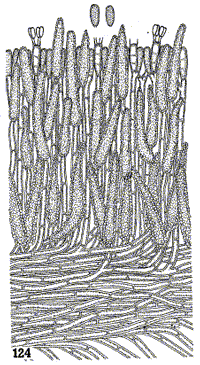|
 Phanerochaete areolata Phanerochaete areolata
SynonymsLopharia areolata
BiostatusPresent in region - Indigenous. Endemic
Images (click to enlarge)
Caption: FIG. 124. Lopharia areolata. Showing the irregular rows of metuloids and the
elliptical spores. |
Article: Cunningham, G.H. (1963). The Thelephoraceae of Australia and New Zealand. New Zealand Department of Scientific and Industrial Research, Bulletin 145: 359 p. Wellington:.
Description: Hymenophore annual, membranous, forming irregular areas either in the form of
numerous colonies with reflexed upper margins, when 2-5 cm across, or as linear
resupinate areas to 30 x 3 cm with reflexed lateral margins. Pilei effused-reflexed,
sometimes reduced to upturned edges, to 5 mm radius, length of the fructifications;
surface straw colour, pallid ochre with tan or reddish-brown margins, bearing coarse
hairs either in strigose tufts, or imbricately, edges lobed or torn, often incurved;
hymenial surface cream, then alutaceous, even, becoming deeply areolately creviced.
Context white, 250-400 µ thick, of mainly parallel hyphae and a deep subhymenium
containing metuloids; without a cortex; generative hyphae 4-6 µ diameter, walls 0.2-1
µ thick, naked, without clamp connections. Metuloids crowded in the hymenium and
subhymenium, forming a layer to 160 µ deep, of 3-7 overlapping rows, in thick
specimens occupying the greater part of the context, some projecting to 20 µ,
cylindrical with rounded apices, or subfusiform with acuminate apices, some
flexuous, 30-65 x 7-9 µ, encrusted throughout, more coarsely below, the brief pedicels
naked. Hymenial layer to 50 µ deep, a close palisade of basidia, paraphyses, and
metuloids. Basidia subclavate, 20-24 x 4-5.5 µ, bearing 2-4 spores; sterigmata erect,
slender, to 5 µ long. Paraphyses subclavate or subcylindrical, 16-20 x 3-4.5 µ. Spores
oblong-elliptical, a few narrowly obovate, apiculate, 6-8 x 3-3.5 µ, walls smooth,
hyaline, 0.1 µ thick.
Habitat: HABITAT: Bark of dead branches.
Distribution: TYPE LOCALITY: Lake Mapourika, Westland, New Zealand.
DISTRIBUTION: New Zealand.
Notes: Of the three species with monomitic hyphal systems L. areolata may be identified by
the delicate hymenophore, small metuloids with brief hyaline pedicels, and absence of
clamp connections. The context of pileate specimens consists of a broad layer of
mainly parallel hyphae from which arise the abhymenial hairs, bordered by a deep
layer of erect hyphae containing the metuloids; in resupinate specimens the context is
composed mainly of intertwined hyphae as in members of the Corticeae. Lower
metuloids are more coarsely encrusted, crystals becoming progressively finer towards
the surface.
|